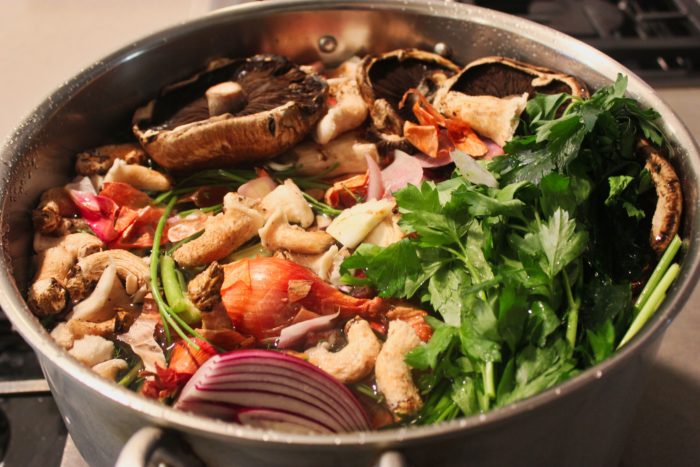
When it arrives on your table, a dish should be beautiful. In form, in color, and even in aroma. While that final plating is quite important, having beauty every step of the way is certainly beneficial.
Here’s a shot of last week’s vegetable stock from Suzi’s cooking school, Cooking by the Book. Actually, it is not stock, it is broth. The difference between “stock” and “broth” often confounds me, and others too I know. We tend to use the word interchangeably now. One is made from bone and one with meat. If “broth” meant “bone” that would be helpful. It’s not. It’s the other way around with broths made with meat [or just veggies] and stock always made with bones.
The bone component is important. A broth, made with meat, is a nicely flavored liquid according to Alton Brown. Stock, on the other hand, made with bones and cooked for hours to extract the collagen is thicker and ostensibly richer.
Suzi makes both, particularly turkey stock/broth where she throws in both meat and bones. And then cooks for six hours to achieve a powerfully rich liquid. Just heat that liquid up, add some noodles and you have something quite incredible on your table.
This picture shows our latest shot at vegetable broth. Recipes will tell you to keep all your scraps for a weekly batch of broth. And we do that, including those onion skins. But we don’t add just scraps. We clean out the fridge. So you see whole mushrooms there, which could be used for any dish, but they are destined for duty as broth. The mushroom stems, too!
Broth recipes often say to add the ingredients, those scraps, cover with water and boil for a few minutes. We boil for hours. The resulting broth looks dark and has the aroma of, well, a finely-honed stock. The secret is those mushrooms which contribute color as much as flavor.
Other elements you can add include the usual suspects:
Onions, scallions, leeks or other cousins
Celery
Carrots
Diced potatoes [and, yes, potato skins]
Garlic cloves to your liking [see below]
Bay leaves [remember to fish them out]
Parsley or cilantro or even both
Salt and pepper
Parmesan rinds
Because your broth may be destined for a variety of future service — soups, sauces, gravies, risottos — your addition of salt and pepper here should be modest. You can add later but subtracting too much salt is an impossible journey.
Recipes do differ about using elements with more intense flavor, like garlic. You will see recommendations for making a vegetable stock with “neutral but savory flavors.” I appreciate the advice, but Suzi and I do like intensity, so some garlic is always an element for us.
At kitchn.com, they advise against potatoes and other starchy elements, saying they produce gummy and cloudy stock. Nobody wants gummy, but clarity is not a necessity. I think the guidance here is to use a modest amount, if any, and of course you are straining the cooking liquid anyway. Kitchn.com is also averse to beets, which can overpower, and both zucchini and green beans with become bitter if cooked for a long time. Since we let our broth simmer for hours, we follow that advice.
Suzi is an advocate of the Parmesan rinds. She’s certain they add a new and deep layer of flavor.
Once made and cooled, you can package your broth in, say, quart containers and put in your fridge. Or, freeze and save for a rainy day when you need a dash of comfort food.
Source: Suzi O’Rourke
Photo Information: Canon T2i, EFS 60mm Macro Lens, F/4.5 for 1/5th second at ISO‑800
